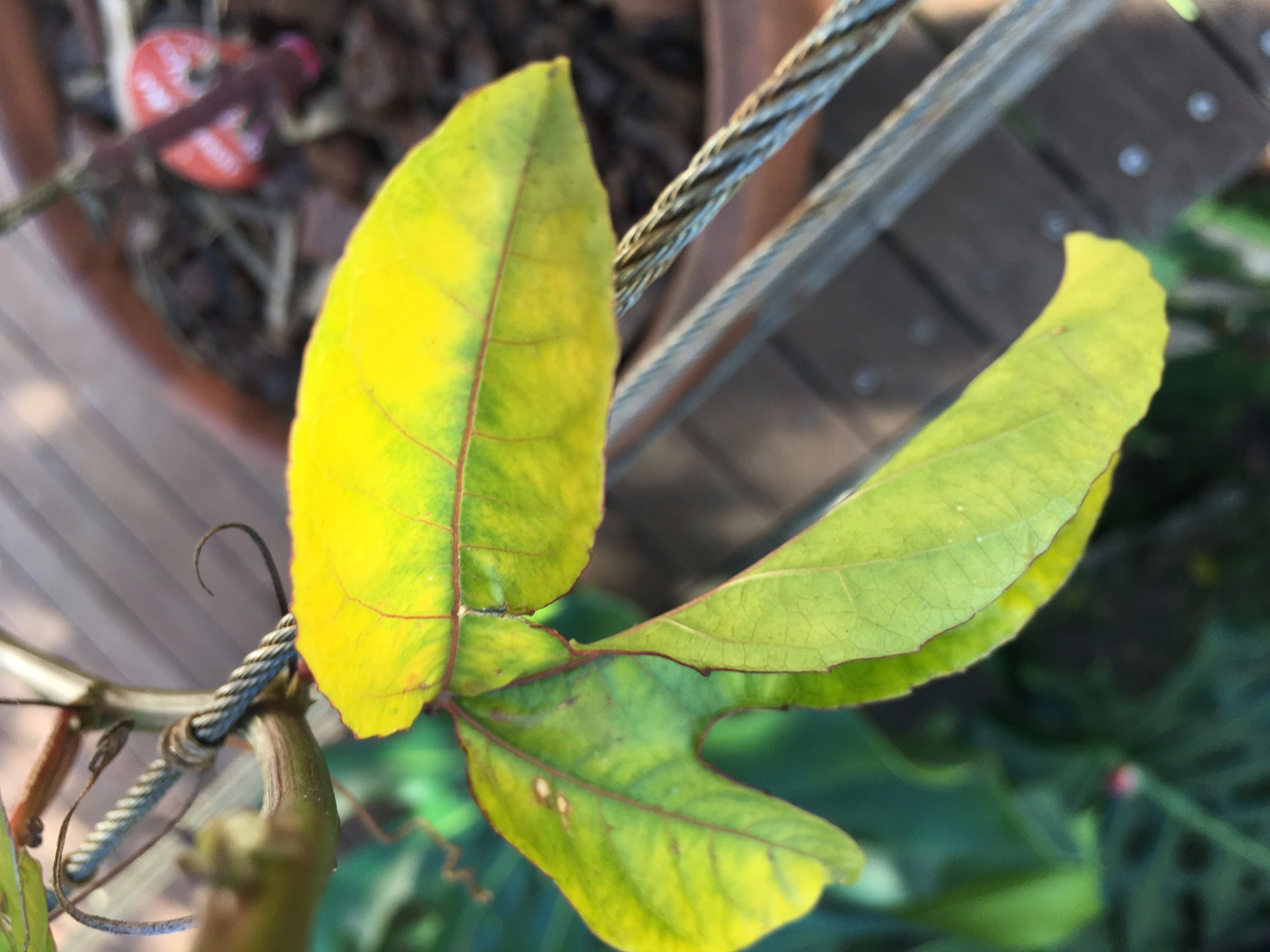Seeing those vibrant green leaves on your passion fruit vine slowly turn yellow can be worrisome for any gardener. But don’t fret – yellow leaves are usually a sign that your plant needs a bit of extra care and attention. With a few easy fixes, you can get your passion vine back to its glossy, green glory.
What Causes Yellow Leaves on Passion Fruit Plants?
There are a few key culprits that could be behind the yellowing of passion fruit leaves:
-
Insufficient Water Lack of water is a common cause of yellowing leaves. When the soil dries out completely, the oldest leaves often yellow first. For potted passion vines it’s essential to water thoroughly and regularly to keep the soil moist.
-
Nutrient Deficiencies: Important nutrients like nitrogen, magnesium, and iron are needed for lush, green growth. If the soil is lacking, leaves can turn yellow. Nitrogen deficiency typically causes uniform yellowing, while iron or magnesium issues lead to yellowing between the veins.
-
Cold Weather: Passion fruit vines thrive in warmth and can react to cold snaps by yellowing leaves. Exposure to cold winds or frost can also damage leaves.
-
Pests: Sucking insects like aphids, spider mites, and whiteflies drain resources and cause mottled yellowing.
-
Diseases: Fungal diseases like fusarium wilt and root rot can infect roots and lead to yellowing leaves.
Quick Fixes to Restore Green Leaves
Luckily, with a few simple fixes, you can get your passion fruit leaves back to green in no time:
-
Water thoroughly: Check soil moisture and water vines when the top inch of soil is dry. Soak the entire root zone, but avoid overwatering.
-
Use a fertilizer: Apply a balanced liquid fertilizer to provide nitrogen, phosphorus, and potassium. Or use targeted amendments like blood meal or Epsom salts.
-
Control pests: Remove pests with gentle horticultural oils or introduce beneficial insects like ladybugs.
-
Improve air circulation: Thin vines to open up air flow and reduce disease risk. Space vines properly to allow airflow.
-
Remove diseased foliage: Dispose of any yellowed leaves showing signs of fungal disease to prevent spreading.
Preventing Future Yellowing
An ounce of prevention is worth a pound of cure when it comes to yellow passion fruit leaves. Here are some tips to keep your vine’s foliage healthy and green:
-
Check soil nutrients: Test soil annually and amend as needed to maintain proper nutrient levels. Work in compost to enrich soil.
-
Water wisely: Invest in a moisture meter and check soil before watering. Let the top inch dry out before soaking thoroughly.
-
Use mulch: A 2-3 inch layer of mulch conserves moisture and insulates roots from temperature swings.
-
Control pests: Monitor vines vigilantly and remove pests before they spread. Natural predators like ladybugs help keep pests in check.
-
Promote airflow: Allow adequate space between vines and prune selectively to improve air circulation and decrease fungal disease risk.
-
Plant resistant varieties: Choose passion fruit varieties bred to be resistant to common diseases like fusarium wilt.
When to Worry About Yellow Leaves
Mild yellowing of older leaves is normal as passion vines age. But if yellowing is severe, rapid, or combined with wilting, it likely indicates a bigger issue that demands quick action:
-
Sudden wilt: If vine leaves rapidly wilt and turn yellow, check for root damage from waterlogging or disease.
-
Veinal yellowing: Interveinal yellowing can mean magnesium or iron deficiency and should be corrected with fertilizer.
-
Curling and spotting: Yellow leaves that curl or develop brown spots could indicate pest, disease, or virus issues that may require treatment.
-
Progressive yellowing: If yellowing worsens and spreads after fertilizing and watering correctly, an underlying disease, pest infestation, or environmental issue is likely the cause.
By staying vigilant and addressing problems early, you can keep your passion fruit’s foliage flourishing. Trust your instincts – if anything seems off, start inspecting and correcting. With a bit of TLC, those yellow leaves will be green again soon.
Why Are My Plant Leaves Yellow? | Simple Secrets To Fix It!! | Leaves So Green It Hurts!!
FAQ
How do you fix yellow leaves on passionfruit?
Can passionfruit be overwatered?
What is lacking when leaves turn yellow?
What do I do if my plant leaves are turning yellow?
Why do passion fruit leaves turn yellow?
Passion fruit plants require a balanced supply of nutrients to grow properly, and a lack of essential nutrients such as nitrogen, phosphorus, or potassium can cause the leaves to yellow. Another common cause is overwatering, which can lead to root rot and nutrient deficiencies. What are the common reasons for passion fruit leaves falling off?
What diseases affect passion fruit plants?
One of the most common viral diseases that can affect passion fruit plants is the cucumber mosaic virus. This virus is carried by aphids, and it can cause yellow patches on the leaves. The leaves will eventually curl up and die.
Why is my passion fruit wilting?
Underwatering can also cause yellowing of passion fruit leaves. When a plant does not receive enough water, it can become stressed, leading to yellowing and wilting of the leaves. In severe cases, the plant may die. To prevent underwatering, ensure that the plant receives sufficient water.
What pests eat passion fruit plants?
Common pests that attack passion fruit plants include aphids, mites, and whiteflies. These pests feed on the leaves, sucking out the sap and causing damage. As a defense mechanism, the plant may shed its damaged leaves, leading to yellowing or discoloration. Inspect your passion fruit plant regularly for signs of pests.
- The Ultimate Guide to Growing Strawberries in Raised Beds - August 8, 2025
- No-Dig Garden Beds: The Easiest Way to Grow a Beautiful Garden - August 6, 2025
- How to Protect and Preserve Wood for Raised Garden Beds - August 6, 2025

